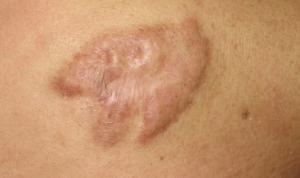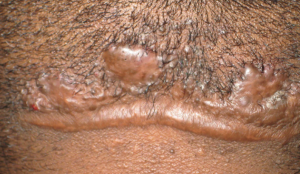Chapter 15: Other Dermatologic Conditions
Scars: Keloid Scar
A keloid scar extends beyond the wound margins into the adjacent normal skin. The onset is delayed, and they are not always preceded by a significant injury. Keloid scars are often painful or itchy.

Keloid scars are more common in younger patients, patients with skin of colour, those with a prior history of a hypertrophic or keloid scar. Shoulder, chest, upper back or ear are common sites.

Prevention of keloid scars is important and unnecessary procedures should be avoided in high risk patients. Topical silicone sheets or gels and massage may help to prevent formation of hypertrophic and keloid scars, but there is insufficient evidence to recommend this routinely and these products can be expensive. If there is very high risk of keloid formation, intralesional triamcinolone might be injected post-operatively.
Intralesional corticosteroid injections with triamcinolone acetonide (TAC 20-40 mg/cc) is most commonly used in treatment. Of note, keloid scar injections are painful and only small volumes can be injected each session due to the tight nature of the scar. Some keloid scars are excised, and careful wound care put in place to prevent recurrence.

